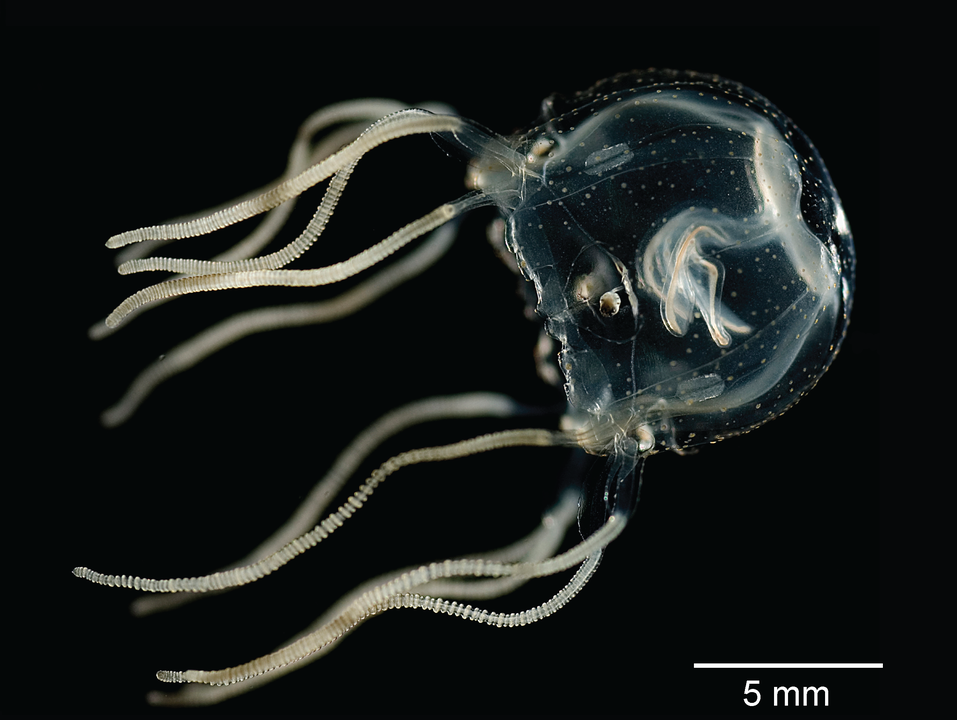Animals can learn all kinds of behaviours. Rats learn to avoid foods that make them sick, cockatoos learn to open garbage bins to get to the food inside, and bees learn to roll balls to obtain nectar. For a long time, scientists believed that a brain is necessary to learn how to behave to obtain something nice or avoid unpleasant consequences. But now brainless box jellyfish prove them wrong.
Researchers studied the Caribbean box jellyfish, which is less than a centimetre and in the wild lives in mangrove lagoons. They look for their prey between the prop roots of mangrove trees. Since their bodies are soft and fragile, it’s important that they avoid collisions with the plants. To do that they use their tiny eyes*, which are quite similar to our own. To avoid obstacles jellyfish assess the distance to objects by using the contrast between it and the surrounding water. However, this contrast changes depending on the clarity of the water, which can vary a lot, depending on the weather, tides, waves, or algal growth.
Learning could be a good strategy to adjust to such a changing environment. But can jellyfish learn to avoid obstacles if they have no brain? Box jellyfish have a nervous system but it is more like a net spread throughout their body, without one central control centre. They have four small nerve cell clusters (around 1000 cells) close to their four eye-bearing organs. But is that enough?
Researchers performed experiments in circular tanks whose walls could be covered by different patterns. First, they let jellyfish swim in a tank with black-and-white vertical stripes resembling tree roots on the wall. None of the jellyfish collided with the wall in this setting.
When the walls had grey-and-white stripes, and therefore the contrast between the stripes was lower, initially jellyfish were not able to avoid the wall, but over the course of a 7.5-minute experiment, they improved considerably, reducing the number of collisions over time by increasing their avoidance behaviour – swimming away from the wall.
To learn they needed visual input. When the walls were completely grey (like turbid water) jellyfish collided with them and did not become better at avoiding them over time.
Additional experiments looking at the activity of their nerve cells indicated that box jellyfish combine visual information with mechanical stimulation from collisions to learn and improve their avoidance manoeuvres.
Therefore, a brain is not necessary to learn and to adjust own behaviour depending on the circumstances, and “brainless” may not be such an insult as previously believed.
* Box jellyfish have 4 sets of 6 eyes. Two of these eyes are built similarly to ours with lenses and retina and can form images.
Polską wersję tego wpisu możesz znależć tutaj.
Photo: By Jan Bielecki, Alexander K. Zaharoff, Nicole Y. Leung, Anders Garm, Todd H. Oakley (edited by Ruthven (talk)) – Jan Bielecki; Alexander K. Zaharoff, Nicole Y. Leung, Anders Garm, Todd H. Oakley (June 2014). "Ocular and Extraocular Expression of Opsins in the Rhopalium of Tripedalia cystophora (Cnidaria: Cubozoa)". PLOS ONE 9 (6). DOI:10.1371/journal.pone.0098870., CC BY-SA 4.0, https://commons.wikimedia.org/w/index.php?curid=35741131

